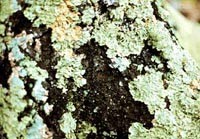Resource Library
Plant of the Week: Lichens, Foliose
The University of Arkansas System Division of Agriculture does not promote, support or recommend plants featured in "Plant of the Week." Please consult your local Extension office for plants suitable for your region.
Plant of the Week
Foliose Lichens
Latin: Parmelia sp.

In the midst of a record cold winter it might be encouraging to examine an organism
that actually flourishes during this type of weather. Lichens love cold weather. In
fact, they only grow in the winter when temperatures are below 50 degrees. They go
dormant during the summer heat.
Lichens are everywhere in our environment, but few of us know, or perhaps care, much
about them. But like all of Mother Nature’s bounty, they have a fascinating story
to tell.
What makes lichens unique is that they are a symbionts – sort of the Borgs of the
plant kingdom. The fungal part of the association primarily falls to one of the species
of ascomycetes, or cup fungi. The algal part of the symbiosis relies on just two species
that are found in 70 percent of all lichens.
The algae function in photosynthesis and sometimes nitrogen fixation, while the fungus
provides structure and support for the algae. These species have evolved to the point
that they cannot live without their partner. Being somewhat prudish, they don’t have
sex but reproduce vegetatively.
More than 13,500 kinds of lichens have been identified. These are broken down into
three major categories. The foliose (leaf-like) lichens are the most common types
that grow on the trunks of trees or on rocks in the shady woods. They’re usually gray-green
and form more or less circular colonies.
The glamorous lichens are the fruticose (shrub-like) lichens that grow more or less
like real plants. Of this group, the two most prominent in Arkansas are reindeer moss
(Cladonia sp.), which forms brittle gray buns 6-8 inches across in sunny spots in our mountainous
counties, and old-man’s-beard (Usnea longissima), which looks like Spanish moss and grows in isolated locations where the moisture
and temperature conditions are perfect.
The Rodney Dangerfield’s of the lichen clan are the crustose (crustose) lichens that
grow closely adhered to or inside rocks. These are often colorful shades of yellow,
green, orange or black. They are hard to study. Arkansas probably has about 300 kinds
of lichens counting the foliose and fruticose types, but no one knows for sure how
many crustose types there are.
Lichens are edible – well sort of. In the tundra region of the far north, the principle
winter browse of reindeers is reindeer moss, the same species that occurs here. European
explorers of the arctic regions learned that foliose lichens growing on rocks could
be eaten if all other food sources were depleted. No doubt it tasted better if they
called it by its French name, tripe de roche, which translates roughly as "guts of
the rock."
The foliose lichens found on rocks are very slow growing. They usually grow less
than a millimeter a year. By comparing the size of a colony with the known growth
rate of a given species, fairly accurate dating is possible. In fact, a special branch
of archeology uses the growth rate of lichens as a means of dating structures.
Lichen encrusted stone is more valuable to the stone pickers of Arkansas than field
stone without a comparable patina. But unfortunately, transplanted lichens seldom
survive being moved from a cool shaded forest to the side of your house. Of course,
dead lichens look almost like living lichens, so hardly anyone notices.
Eventually, a new species of lichen will colonize your native stone facade, so just
have patience. Of course, at a millimeter a year, it will be some time before you
have much to brag about.
By: Gerald Klingaman, retired
Extension Horticulturist - Ornamentals
Extension News
The University of Arkansas System Division of Agriculture does not maintain lists of retail outlets where these plants can be purchased. Please check your local nursery or other retail outlets to ask about the availability of these plants for your growing area.